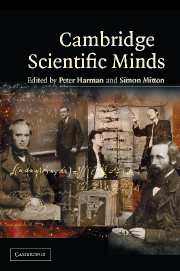Book contents
- Frontmatter
- Contents
- Foreword
- Introduction
- 1 William Gilbert
- 2 William Harvey
- 3 Isaac Newton: Creator of the Cambridge scientific tradition
- 4 William Whewell: A Cambridge historian and philosopher of science
- 5 Adam Sedgwick: A confident mind in turmoil
- 6 Charles Babbage: Science and reform
- 7 Charles Darwin
- 8 Stokes and Kelvin, Cambridge and Glasgow, light and heat
- 9 James Clerk Maxwell
- 10 The duo from Trinity: A.N. Whitehead and Bertrand Russell on the foundations of mathematics, 1895–1925
- 11 Thomson, Rutherford and atomic physics at the Cavendish
- 12 Hopkins and biochemistry
- 13 Charles Sherrington, E.D. Adrian, and Henry Dale: The Cambridge Physiological Laboratory and the physiology of the nervous system
- 14 Hardy and Littlewood
- 15 Arthur Stanley Eddington
- 16 Paul Dirac: A quantum genius
- 17 Alan Turing
- 18 Francis Crick and James Watson
- 19 Mary Cartwright
- 20 Joseph Needham
- 21 Molecular biology in Cambridge
- 22 The discovery of pulsars – prelude and aftermath
- 23 Stephen W. Hawking
Foreword
Published online by Cambridge University Press: 05 June 2014
- Frontmatter
- Contents
- Foreword
- Introduction
- 1 William Gilbert
- 2 William Harvey
- 3 Isaac Newton: Creator of the Cambridge scientific tradition
- 4 William Whewell: A Cambridge historian and philosopher of science
- 5 Adam Sedgwick: A confident mind in turmoil
- 6 Charles Babbage: Science and reform
- 7 Charles Darwin
- 8 Stokes and Kelvin, Cambridge and Glasgow, light and heat
- 9 James Clerk Maxwell
- 10 The duo from Trinity: A.N. Whitehead and Bertrand Russell on the foundations of mathematics, 1895–1925
- 11 Thomson, Rutherford and atomic physics at the Cavendish
- 12 Hopkins and biochemistry
- 13 Charles Sherrington, E.D. Adrian, and Henry Dale: The Cambridge Physiological Laboratory and the physiology of the nervous system
- 14 Hardy and Littlewood
- 15 Arthur Stanley Eddington
- 16 Paul Dirac: A quantum genius
- 17 Alan Turing
- 18 Francis Crick and James Watson
- 19 Mary Cartwright
- 20 Joseph Needham
- 21 Molecular biology in Cambridge
- 22 The discovery of pulsars – prelude and aftermath
- 23 Stephen W. Hawking
Summary
For much of its almost 800-year history, Cambridge University's greatest minds devoted themselves to fields other than science as we know it. As this book shows, it was not until the time of William Gilbert in the late sixteenth century, already three centuries into the University's life, that science in our sense began to characterise its life and work.
Of course, as we see here, the foundations existed, especially in the mathematical studies, which later came to underlie the whole Cambridge curriculum and provided the soil in which science was to be planted and grow. Isaac Newton in particular, who shines in the firmament of Cambridge stars, continues to inspire our mathematical and physical studies, not least in the new Institute which bears his name.
In 1664, in Newton's prime, the new Royal Society of London took as its motto ‘Nullius in verba’ (‘on the word of no man’), signifying that evidence, tangible data, and experience repeated at will were to be the marks of scientific endeavour. Merely to quote opinion or authority was in future to be valueless. And so, from then, we move into what is increasingly recognisable as the modern world of scientific inquiry, and pass to the era of Cambridge's greatest contributions to our knowledge of the world.
From then until our own day the progress of Cambridge and of the World's science studies is clear, as these chapters skilfully describe.
- Type
- Chapter
- Information
- Cambridge Scientific Minds , pp. vii - viiiPublisher: Cambridge University PressPrint publication year: 2002



